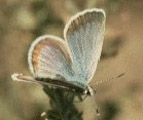Native Plants
Search for native plants by scientific name, common name or family. If you are not sure what you are looking for, try the Combination Search or our Recommended Species lists.
Atriplex canescens
Atriplex canescens (Pursh) Nutt.
Chamiso, Four-wing Saltbush, Wing-scale
Chenopodiaceae (Goosefoot Family)
Synonym(s):
USDA Symbol: atca2
USDA Native Status: L48 (N), CAN (N)
Four-wing saltbush is a 3 ft., semi-evergreen shrub which can reach 8 ft. Summer flowers are insignificant, but the clusters of gold-tan, four-winged fruits, which occur on female plants only, are showy. The branches and small, narrow leaves of this mound-shaped shrub are covered with a dense, silvery pubescence. Extremely variable shrub: compact and rounded; sprawling and low; to open-branched and treelike.
There are many varieties of Four-winged Saltbush. The plant is known to hybridize with at least a dozen other Atriplex species, and new forms and varieties continue to arise.
Plant Characteristics
Duration: PerennialHabit: Shrub
Root Type: Tap
Leaf Retention: Evergreen
Leaf Complexity: Simple
Leaf Shape: Linear
Leaf Margin: Entire
Breeding System: Flowers Unisexual , Dioecious
Fruit Type: Achene
Size Notes: Up to about 8 feet tall.
Leaf: Green.
Fruit: Brown, four-winged.
Bloom Information
Bloom Color: YellowBloom Time: Mar , Apr , May , Jun , Jul , Aug , Sep , Oct , Nov
Distribution
USA: AZ , CA , CO , ID , KS , MT , ND , NE , NM , NV , OK , OR , SD , TX , UT , WA , WYNative Distribution: ND to Alt. & e. WA, s. to TX, AZ & Baja CA
Native Habitat: Dry, barren flats; slopes; washes
Growing Conditions
Water Use: MediumLight Requirement: Part Shade
Soil Moisture: Dry
CaCO3 Tolerance: High
Soil Description: Alkaline, well-drained soils. Saline tolerant, Caliche type, Limestone-based, Sandy, Sandy Loam, Medium Loam Clay Loam Clay Calcareous
Conditions Comments: Will work in extremely dry, salty conditions and is recommended for its durability rather than its beauty. Useful for stabilizing soil and providing wildlife cover. Saltbush can be very invasive and difficult to eradicate, especially in wetlands. Severe pruning produces better specimens. If planting in a rabbit or deer area, plants will need to be caged until foliage reaches 3-4 ft.
Benefit
Use Ornamental: Showy, Fall conspicuous, Fruits ornamental, Erosion controlUse Wildlife: Important as wildlife cover and food plants. Fruit-mammals, Fruit-birds, Nectar-bees, Nectar-insects
Warning: This plant may accumulate levels of the soil mineral selenium that makes it toxic to livestock.
Conspicuous Flowers: yes
Butterflies and Moths of North America (BAMONA)
|
San Emigdio Blue (Plebejus emigdionis)  Larval Host |
Mohave Sootywing (Hesperopsis libya)  Larval Host |
Saltbush Sootywing (Hesperopsis alpheus)  Larval Host |
Propagation
Propagation Material: SeedsDescription: Increase by seed sown in spring or softwood cuttings taken from late spring to early fall.
Seed Collection: Gather by hand when ripe in late summer or fall. Cleaning or dewinging before storage is not necessary although the bracts contain high accumulations of soluble salts which may inhibit germination. Store seed in cloth or paper bags in a dry, cool place. Seeds must undergo a 10 month period of after-ripening.
Seed Treatment: Germination of many Atriplex species can be increased by presoaking the fruits and then wringing the water and dissolved salts from the material.
Commercially Avail: yes
Find Seed or Plants
Order seed of this species from Native American Seed and help support the Wildflower Center.
Find seed sources for this species at the Native Seed Network.
View propagation protocol from Native Plants Network.
From the National Organizations Directory
According to the species list provided by Affiliate Organizations, this plant is on display at the following locations:Santa Barbara Botanic Garden - Santa Barbara, CA
Texas Discovery Gardens - Dallas, TX
Sibley Nature Center - Midland, TX
Texas Parks and Wildlife Department - Austin, TX
Native Seed Network - Corvallis, OR
Bibliography
Bibref 1186 - Field Guide to Moths of Eastern North America (2005) Covell, C.V., Jr.Bibref 1185 - Field Guide to Western Butterflies (Peterson Field Guides) (1999) Opler, P.A. and A.B. Wright
Bibref 318 - Native Texas Plants: Landscaping Region by Region (2002) Wasowski, S. & A. Wasowski
Bibref 291 - Texas Wildscapes: Gardening for Wildlife (1999) Damude, N. & K.C. Bender
Search More Titles in Bibliography
Web Reference
Webref 30 - Calflora (2018) CalfloraWebref 38 - Flora of North America (2019) Missouri Botanical Garden, St. Louis, MO & Harvard University Herbaria, Cambridge, MA.
Webref 36 - Jepson eFlora (2019) The Jepson Herbarium, University of California, Berkeley
From the Archive
Wildflower Newsletter 1990 VOL. 7, NO.1 - Congress Eyes Larger Issue, Research Update, Director's Report, Carlton B. Lees ...Additional resources
USDA: Find Atriplex canescens in USDA PlantsFNA: Find Atriplex canescens in the Flora of North America (if available)
Google: Search Google for Atriplex canescens
Metadata
Record Modified: 2022-10-17Research By: TWC Staff